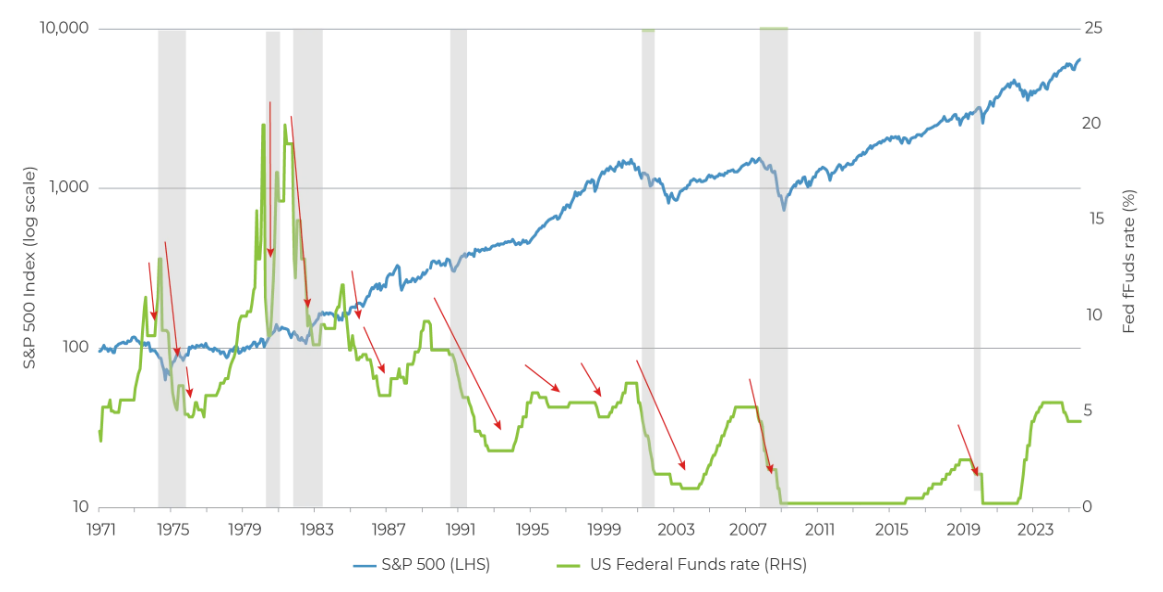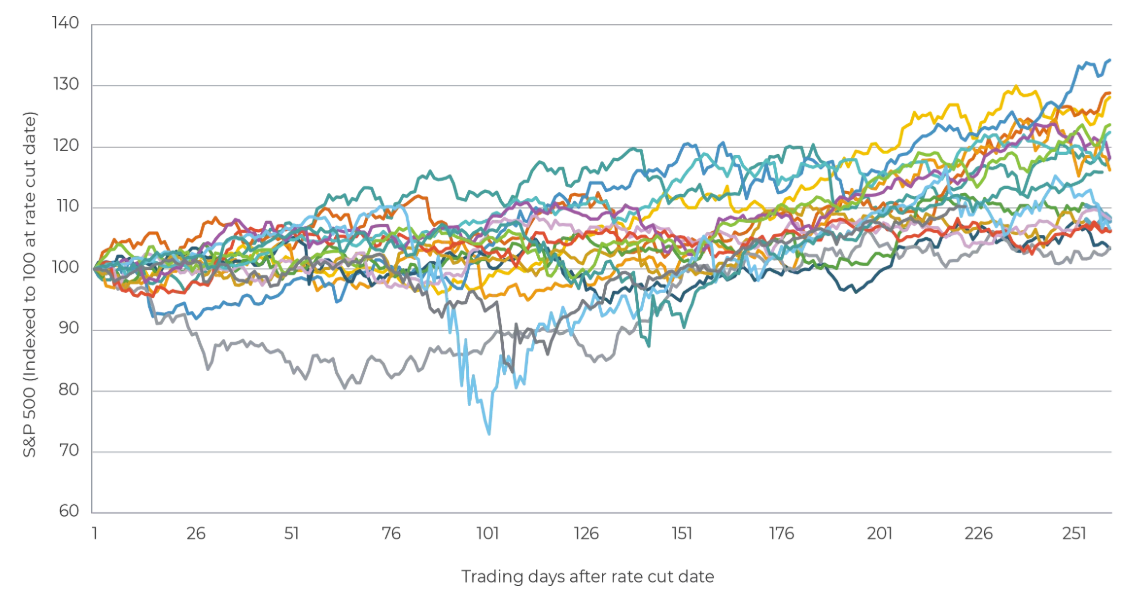How to steer portfolios after Fed rate cuts
After a nine-month hiatus, the US Federal Reserve (Fed) has restarted its interest rate easing cycle. At September’s meeting, the Fed cut the Federal Funds Rate by 25 basis points, and members of the Fed board have indicated they believe another 50 basis points are likely before year end, followed by another 25 basis points in the first half of 2026. This has naturally set investors abuzz. Does this mark the start of a new bull surge, or signal caution at the top? But the more important question, in my view, is how to position now to capture the next phase of market leadership?
Anticipating market trends for 2025
In one of my earlier musings this year, Amid a tornado of headlines, where does the opportunity lie for global investors in 2025?, I examined the market outlook for 2025. I concluded that, after a very strong 2023/24, which ranked in the top 5% of outcomes for any 24-month period in nearly a century, history suggested the next 12-months would, on average, deliver roughly zero returns. With valuation multiples then trading in the top decile of their historical averages, I judged further multiple expansion unlikely, implying that earnings growth would need to drive market returns. On that basis, following back-to-back 20%+ per annum returns in both 2023 and 2024, my view was that 2025 would likely require a reset in expectations, with investors looking to 10% as an upper limit for equity returns in 2025, with some downside risk.
April’s Liberation Day initially validated that caution, sending shockwaves throughout equity markets across the globe. However, this correction was short lived, and markets soon shrugged off tariff fears with ease. As at the time of writing this note (2 October), the US equity market is up ~14% year to date, making my earlier expectation of a 10% return cap for 2025 look too conservative. So, where do we go from here?
Historical easing cycles: Lessons from the past
A good starting point is to use history as a guide and examine previous easing cycles. Since 1970, there have been 14 notable easing cycles with multiple rate cuts (in total, there have been more than 14 but some consisted of a single cut followed by nothing, so I’ve excluded those episodes as one-offs and not true easing ‘cycles’).
In other words, the path of the economy matters more than the path of rates.
On average, equity markets rose by 6% during these easing cycles (I’m only measuring the equity market return while rates are being cut. Once they reach a bottom and plateau, I stop measuring the returns as I view the rate easing cycle has ceased). The chart below illustrates this point – the S&P 500 Index is in blue, represented by a logarithmic scale, the Fed Funds Rate is in yellow, and the red arrows point to the easing cycles I have used.
Rates and returns: How Fed moves meet the S&P 500

Source: FIL, FactSet
However, not all easing cycles are the same. Some occur after the economy has weakened significantly, and therefore take place during a recession, while others are more pre-emptive and result in a soft landing. In the chart above, I have also shaded in grey areas to highlight official recessionary periods, as defined by the National Bureau of Economic Research (NBER).
If we split easing cycles into two categories: one with a recession and one without a recession, we see two vastly different outcomes. When rate cuts arrive during a recession, equity markets fall on average around 7%. When rate cuts occurred without a recession, think 1985, 1986, 1995, 1998, and 2024, equities gained roughly 16% on average. In other words, the path of the economy matters more than the path of rates. As an investor in global markets, I’ve seen this pattern bleed into international markets as well: when central banks ease into a soft landing, breadth improves, financing conditions ease, and market leadership tends to broaden.
Equity markets and interest rates
Exploring the data even further, there’s another nuance worth highlighting. September’s interest rate cut was the seventeenth time since 1980 the Fed cut interest rates while the equity market stood within 1% of all-time highs. Keep in mind this is measuring individual interest rate cuts, not cycles. You can get multiple cuts within a cycle that take place while markets are rising, making new highs. For example, the 1989-1992 easing cycle had six individual rate cuts where the market was at or near all-time highs. In all 16 of these prior cases, the market was up 12 months after the cut every time, (i.e. 100% historical batting average), with an average gain of 15%. However, it wasn’t a straight line.
The chart below shows all prior 16 occurrences and how the US equity market subsequently performed. Every individual line represents a prior episode where the Fed cut rates while the equity market was within 1% of all-time highs, and how the market reacted over the following 12 months.
US equity market performance after rate cut within 1% of all-time highs

Source: FIL, FactSet
There was, on average, a 9% peak to trough pullback during those 12 months, often in the first two to five months after the cut-before new highs emerged and most gains accrued in the back half of the year. That playbook - near-term chop, longer term strength - favours investors who can allocate incrementally during drawdowns and own businesses whose cash flows can compound through volatility.
Putting this altogether, history shows that we may have to sidestep a potentially vulnerable period from now until the end of the year.
If the US avoids a recession while easing proceeds, the US equity bull market might continue and extend its streak of very strong performance since the 2022 cyclical lows.
The way forward
What are the risks? Below are what I believe are the main scenarios, with brief comments on why they seem manageable at this point.
- Earnings growth disappoints: this remains a significant risk given the elevated multiples at which the equity market is trading. For now, evidence is limited, as earnings estimates for CY25 have been revised upwards since April’s tariff shocks.
- US economy enters recession: Recessions typically result in equity market drawdowns, irrespective of interest rate cuts. Year to date, earnings growth is consistent with CY25 earnings growth of around 11% versus CY24. The US economy is slowing but remains positive and has not yet slowed to the point of signalling an imminent recession. With tariff impacts still to flow through the broader economy, this is one to watch.
- The Fed doesn’t follow through on further interest rate cuts: Stubborn inflation is limiting the Fed’s ability to cut rates. A slowing economy might help ease some of the inflationary pressures; nevertheless, the Fed’s forecast of three more rate cuts over the next 12 months was made with them in mind. It’s worth mentioning the Fed is also under increasing pressure to accommodate the administration’s desire for lower interest rates, which could, at the margin, undermine its independence.
- Narrow leadership: The US equity market’s leadership remains narrow, with technology and AI doing most of the heavy lifting. This is neither healthy nor sustainable indefinitely, though for now, the music is still playing. Diversifying away from mega-caps and into sectors beyond technology can help mitigate this risk. Recall that in calendar year 2000, the S&P 500 fell ~8.5% whilst the NASDAQ Composite fell ~38% as the dot.com bubble burst. The S&P 500 was much less concentrated in technology then compared to today, illustrating how avoiding the epicentre of the sell off can result in material outperformance.
Building a resilient portfolio
To effectively navigate current market uncertainties, constructing a diversified portfolio is paramount. For global investors, including a portfolio of high quality, moderately priced small and mid-cap companies with solid growth potential will help to navigate uncertainties ahead. Being invested in quality stocks at moderate valuations can help buffer any short-term corrections, while the focus on growth can also enable the portfolio to participate on the upside.
While macroeconomic context will dictate the path ahead, a diversified and quality-focused portfolio is likely to remain an investor’s best tool amid policy pivots and shifting market leadership.

1 stock mentioned
1 fund mentioned

